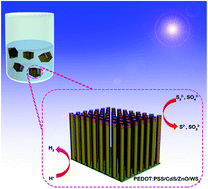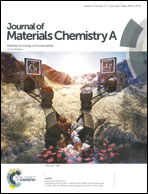Freestanding nano-photoelectrode as a highly efficient and visible-light-driven photocatalyst for water-splitting†
Abstract
Solar energy conversion through artificial photosynthesis is of considerable interest. Unfortunately, the efficiencies of current photocatalysts are limited by the rapid recombination of photogenerated charge carriers and their failure to respond to the long-wavelength light region in sunlight. To harness solar energy efficiently, we propose, for the first time, the concept of freestanding nano-sized photoelectrodes as efficient photocatalysts for artificial photosynthesis applications. Through introducing charge transporting components and incorporating photoactive narrow bandgap semiconductors, a long wavelength responding and freestanding nano-photoelectrode composed of PEDOT:PSS/CdS/ZnO/WS2 has been fabricated. This freestanding nano-photoelectrode can serve as a highly efficient and stable photocatalyst for hydrogen (H2) evolution with a rate of as high as 1028 μmol h−1, without loading any noble metal containing co-catalyst, under simulated sunlight irradiation. Impressively, the designed nano-photoelectrode shows an outstanding apparent quantum efficiency (APQ) of 0.3% for H2 evolution at a wavelength of λ = 600 nm.



 Please wait while we load your content...
Please wait while we load your content...